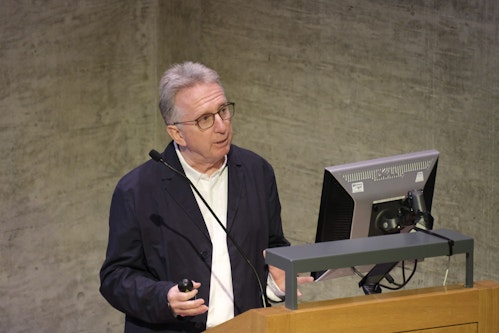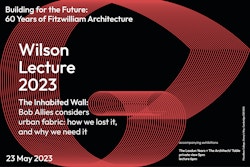/ Wilson Lecture 2023
On urban fabric: how did we lose it, and do we still need it?
by Bob AlliesInvited to deliver the 2023 Wilson Lecture for the 60th anniversary of Fitzwilliam College, Cambridge, Bob Allies examines the unravelling of city fabric and how we might begin to stitch the pieces back together.
Beginning with the concept of the inhabited wall - a term coined by Denys Lasdun in reference to his masterplan for Fitzwilliam - Bob emphasises the distinction between buildings that enclose space and buildings that stand within space. Turning then to the contemporary city, Bob remarks, “it is the building that encloses space – the inhabited wall in Lasdun’s parlance - that makes possible the generation of urban fabric, that is to say, the pattern of streets and squares, courtyards and passages that gives each city its unique structure and identity.”
Delving further, Bob proposes three principles that guide the way the traditional city works: firstly, that buildings coalesce to form a matrix, in multiple ownership, divided by streets and lanes. Resolution must involve agreement by all parties on such principles as party walls and building lines. Secondly, within the matrix, every type of use can be accommodated. And finally, all buildings within the matrix have a responsibility to turn the corridors of movement into spaces. Façades are considered not just as the outside face of a building, but as the inside face of an external room. Proposing that together these principles can embody a remarkable range of feeling; "every era has offered new interpretations of their potential." Bob continues, “in many ways, it’s the informal nature of the process by which urban fabric evolves that is its most intriguing aspect.”
The principle of sharing is fundamental to making settlements work, Bob suggests. The notion of overlap; the way in which any one component has more than one function, and that of interdependence; the symbiotic relationship of these components. Bob explains how significant movements and lifestyle characteristics of the 19th and 20th centuries led to a move towards openness, towards the escape of the city and in doing so began to deconstruct this urban character. As a result, an enormous amount was lost.
“In the urbanism of the twentieth century, it was the building that stood in space, the freestanding building, that became dominant. And as a consequence, the fabric of our villages, towns and cities began to unravel. And unravelled to such an extent that today a large part of the work of practices like ours – both as architects and planners - involves recovering and repairing damaged urban fabric, putting the pieces of the city back together again.”
Noting that where many contemporary architects and urbanists interpret this as “intensity and complexity” planners of the time, “saw only muddle and confusion. Their response – put simply - was to separate things out.” This subsequently led to the principle of zoning - and in the 70s and 80s displacement from town and city centres altogether. The separating of service traffic from through-traffic was encouraged and inner ring roads with roundabouts introduced at junctions left hundreds of British towns and cities irrevocably scarred as a consequence. Bob notes that the urge to separate things out came too from architects; “there was desire amongst architects to sidestep architectural traditions by deriving the form of a building exclusively from its own internal logic.”
Turning next to suburban typology, the idea of the individual family house standing in its own garden, although not new, in the 20th century became a nationwide aspiration, fueling suburban spread and giving rise to the orthodoxy that densities should always be kept as low as possible. In the face of the climate emergency, Bob argues, we are realising we need to be as efficient in our land use as we are with our natural resources; dense, walkable neighbourhoods are the only responsible way forward.
Bob notes a further unravelling of the fabric as a by-product of the increasing role of the state in the commissioning of public buildings due in part to a desire to stand-out from their often unsatisfactory contexts, and for the practical benefits of building on such unencumbered sites. The later still proliferating today.
“What interests us is something more fundamental about how buildings participate in the making of the city, how buildings can work in concert with others to frame and give character to external space, how they can weave urban fabric.” And this, Bob argues, remains essential to the making of successful places today.

